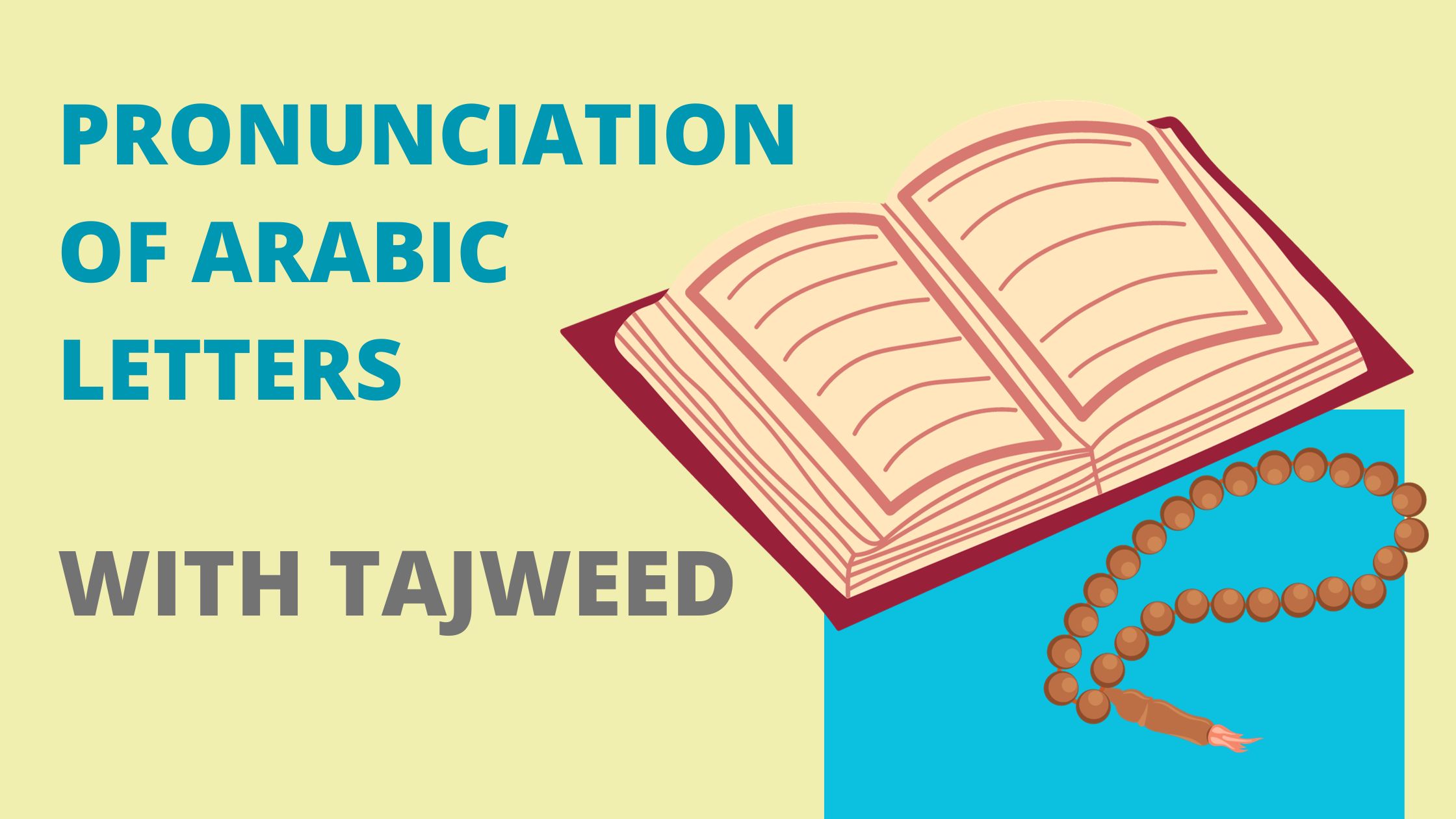In this blog post, we will discuss the complexities of Arabic letters pronunciation in Tajweed and examine their origins and points of articulation.
Tajweed refers to the rules and principles that dictate the correct recitation of the Quran. It entails comprehending the accurate pronunciation, articulation, and features of each letter in Arabic.
Having a grasp on the origins and articulation points of Arabic letters is essential for mastering Tajweed and fully embodying the magnificence and eloquence of the Quran.
Table of Contents
Exploring the Makhaarij Al-Huroof (Articulation Points) of Arabic Letters in Tajweed
The Makhaarij Al-Huroof, or articulation points, are crucial for accurately reciting the Holy Qur’an. Understanding these points allows one to pronounce each letter correctly and capture the true essence of the word.
1. Identifying the Makhaarij Al-Huroof:
The Makhaarij Al-Huroof can be identified by placing a hamzah with a kasra in front of the letter with a sukoon or sheda on it, which helps locate the exit point for any letter.
2. Definition of Makhraj:
The term “Makhraj” refers to the point of articulation in Arabic, and its plural form is “Makharij.” It stems from the Arabic root خَرجَ, meaning “he exited.”
3. Number of Articulation Points:
Scholars have different opinions on the exact number of articulation points, with some suggesting 16 and others suggesting 14.
However, esteemed grammarian Al Khalil and several tajweed specialists, such as Ibn Al Jazari, identify 17 Makharij.
4. Categorization of Arabic Letters:
The Arabic script consists of 28 letters, and when the letter “alif” (ا) is included, the count becomes 29. These letters are broadly categorized into two groups:
A. Asliya, which represents the primary or original letters of the Arabic alphabet.
B. Far’iyya, which are composite letters formed by combining two primary letters. The articulation points for Far’iyya letters tend to shift between two distinct points.
The Oral Cavity (Al-Jawf)
The oral cavity, also known as Al-Jawf, plays a crucial role in the pronunciation of Arabic letters. Here’s a breakdown of its significance:
1. Linguistic Meaning:
The term “Al-Jawf” linguistically refers to an empty space or cavity.
2. Description:
In terms of application, Al-Jawf specifically represents the empty space found between the mouth and the throat. It is the inner region or cavity within the mouth.
3. Sounds Emanating from Al-Jawf:
From the Al-Jawf region, three elongation letters emanate distinct sounds when they have a sukoon (a non-vocalized diacritic mark) and are preceded by specific vowel sounds:
A. The letter ا produces the sound “a” when it has a sukoon and is preceded by a fatha.
B. The letter و produces the sound “oo” when it has a sukoon and is preceded by a damma.
C. The letter ي produces the sound “ee” when it has a sukoon and is preceded by a kasra.
4. Pronunciation Characteristics:
Letters emanating from Al-Jawf are unrestricted in their pronunciation, meaning there are no specific articulation points within the mouth. Instead, the sound ceases only when the speaker’s breath runs out
5. Generalized Articulation Point:
Unlike other makharij (pronunciation points) which have more specific articulation points, the exact articulation point for the letters originating from Al-Jawf is more generalized. This is because these letters heavily rely on the airflow within the oral cavity.
6. Airy Nature of Al Jawf Letters:
These letters are also known as “al huruf al hawa’iyya,” which alludes to their airy nature. This implies that the sounds produced by Al-Jawf have a light and flowing quality due to the unrestricted airflow in the oral cavity.
The Throat (Al-Halq)
The throat referred to as Al-Halq in Arabic, plays a vital role in the pronunciation of specific letters in Tajweed. Here are three outlets and six letters that originate from this articulation point for better understanding:
1. Farthest from the throat:
This refers to the articulation point farthest from the throat and closest to the mouth, specifically where the vocal cords are located. From this outlet, two letters exit:
A. The letter ه (ha): It exits by partially opening the vocal cords.
B. The letter ء (hamzah): There are two forms of hamzah, one stationary (hamzah sakina) which exits by closing the vocal cords, and the other moving hamzah, which exits by distancing the vocal cords.
– Examples: يأكلون (ya’kuloon), ينهون (yanhoon)
2. Middle of the throat:
This refers to the articulation point in the middle of the throat, specifically where the epiglottis is located. From this outlet, two letters exit:
A. The letter ح (ha): It comes from the back slightly and is produced by vibrating the epiglottis.
B. The letter ع (‘ayn): It also originates from the middle of the throat, following the sound of ح.
– Examples: تعملون (ta’maloon), الرحمن (ar-rahman)
3. Nearer to the throat:
This refers to the articulation point closest to the mouth, specifically where the root of the tongue is along the upper soft palate. From this outlet, two letters exit:
A. The letter خ (kha): It is produced by raising the root of the tongue against the upper soft palate.
B. The letter غ (ghayn): It is a similar sound to خ but involves more vocalization.
– Examples: خالدين (khalideen), الغافلين (al-ghafilin)
The Tongue (Al-Lisaan)
The tongue, referred to as Al-Lisaan in Arabic, plays a vital role in accurately pronouncing the various letters. There are 10 distinct points of articulation that give rise to 18 letters, which are important to understand when articulating Arabic letters with the tongue.
1. Farthest Part of the Tongue:
The farthest part of the tongue, against the pharynx and upper palate, is the articulation point for the letter qâf ق. This letter is positioned nearer to the throat.
2. Upper Part of the Tongue:
Just below the articulation point for qaf ق, where the upper part of the tongue meets the upper palate, is where the letter kaf ك emerges.
3. Middle of the Tongue:
The middle of the tongue, meeting the upper palate, produces three letters: djim ج, shin ش, and ya ي (when acting as a consonant).
4. Side of the Tongue:
The side or sides of the tongue, pressing against the upper premolars and molars, articulate the unique letter dad ض.
5. Edge of the Tongue’s Tip:
One edge of the tongue’s tip, against the palatal mucosa, provides the pronunciation for the letter lam ل.
6. Point Above lam:
Slightly above the position for lam, where the tongue’s tip presses the palatal mucosa, is the articulation point for the letter noun ن.
7. Below the noun’s Point:
Just below the noun’s point, where the tip of the tongue pushes against the palatal mucosa while also causing the tongue’s rear to vibrate, is where the letter ra ر is articulated.
8. Tip of the Tongue against Palatal Mucosa:
The tip of the tongue against the palatal mucosa of the upper central incisors articulates the letters ta ت, da د, and Ta ط.
9. Tip of the Tongue and Separating Part:
The tip of the tongue, combined with the part separating the lower central incisors, shapes the sounds for sad ص, shin ش, and zey ز.
10. Resting the Tip of the Tongue:
By resting the tip of the tongue against the tip of the upper central incisors and slightly protruding it between the teeth, the letters Za ظ, dhal ذ, and tha ث are pronounced.
Interested in perfecting your recitation of the Quran? Learn about the different types of Madd in Tajweed to improve your pronunciation and elevate your recitation.
The Lips (Al-Shifatain)
The lips, referred to as Al-Shifatain in Arabic, have a crucial role in correctly pronouncing certain letters. Here are two Makharij to understand how they are articulated:
1. Inner Part of the Lower Lip:
The inner part of the lower lip, pressing against the upper central incisors, creates the sound for the letter fa ف. Additionally, the middle of the lower lip touches the bottom of the upper teeth.
2. Space between the Lips:
The space between the lips serves as the articulation point for three letters:
A. The letter waw و: When acting as a consonant and not a long vowel, it exits between the lips while opening and slightly loosening both lips.
B. The letter ba ب: It exits between the lips while closing them.
C. The letter meem م: It exits between the two lips while closing them but in a stronger manner.
3. The Role of the Lips in Pronunciation:
Understanding the importance of the lips in pronunciation goes beyond the specific letters mentioned above. Neglecting the positioning of the lips can result in mispronunciation and a lack of clarity in speech.
4. Positioning for Kasra:
When articulating the kasra, which represents the short “i” sound, it is crucial to pay attention to the positioning of the lips. To produce a clear “i” sound that does not resemble an “è,”.
It is necessary to elongate the mouth horizontally, similar to a smile. This proper articulation ensures accurate pronunciation and avoids confusion with other sounds.
At Bayan Al-Quran, we offer comprehensive tajweed classes for kids to help them master the art of Quranic recitation. Enroll your child today and witness their love for the Quran grow!
The Nasal Cavity (Al-Khayshoom)
The nasal cavity, also known as Al-Khayshoom, serves as the 17th and final makhraj (point of articulation) in the study of Arabic pronunciation.
1. Function of the Nasal Cavity:
The nasal cavity is a singular outlet responsible for producing the nasalization levels, known as ghunna, within speech.
It plays a specific role in generating nasal resonance, which becomes particularly noticeable when pronouncing certain letters like noon (ن) and meem (م) with a shadda (ّ) diacritic.
2. Ghunna in Sukoon State:
The ghunna effect is not limited to letters with shadda alone. Even when letters like noon, meem, or tanween are in a state of sukoon (no vowel sound), nasalization can still occur.
However, this happens under specific conditions, such as the presence of a preceding or following letter that allows nasalization to take place.
3. Role in Arabic Pronunciation:
The nasal cavity holds a crucial position in Arabic pronunciation, contributing significantly to the production of the characteristic sound of ghunna. By adding nasal resonance to certain letters, it enhances the overall phonetic quality of the language.
Tips for Pronouncing Arabic Letters in Tajweed Correctly
Mastering the pronunciation of Arabic letters in Tajweed requires an understanding of the Makhaarij Al-Huroof or articulation points, and becoming familiar with their sounds. Here are some tips for correctly pronouncing them:
1. Practice regularly:
Consistency is key when it comes to improving your pronunciation. Set aside dedicated time each day to practice reciting Arabic letters and words.
2. Seek guidance from a qualified teacher:
A knowledgeable teacher can provide valuable feedback and corrections as you work on perfecting your pronunciation. They can guide you through proper techniques and help identify any specific areas that need improvement.
3. Listen attentively:
Pay close attention to native speakers or proficient reciters while they pronounce Arabic letters. Immerse yourself in authentic audio recordings or attend live recitations whenever possible.
4. Use visual aids:
Utilize charts or diagrams that illustrate the Makhaarij Al-Huroof, helping you visualize where specific sounds originate within your oral cavity.
5. Repeat after listening:
After hearing an audio clip of correct pronunciation, repeat the sound multiple times until you feel comfortable reproducing it accurately.
6. Start slow and gradually increase speed:
Begin by practicing each letter slowly, focusing on precision rather than speed. As you become more confident, gradually increase your pace while maintaining clarity in enunciation.
Give Your Child a Head Start with Online Arabic Courses for Kids at Bayan Al-Quran
Bayan Al-Quran provides dependable and efficient online Arabic courses for kids, taught by experienced instructors and designed to facilitate the learning of the language of the Quran more enjoyably.
Through interactive lessons, engaging activities, and personalized attention, your child will establish a solid understanding of Tajweed and pronunciation. Enroll your child today to achieve fluency in Arabic!
Conclusion
Mastering the correct pronunciation of Arabic letters is crucial for Tajweed. Practicing and understanding articulation points can improve Quran recitation and strengthen one’s connection to its message.
It is a lifelong learning journey that requires patience and dedication, with online courses such as Bayan Al-Quran’s program available to provide a foundation in Tajweed for children.

















